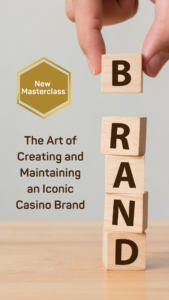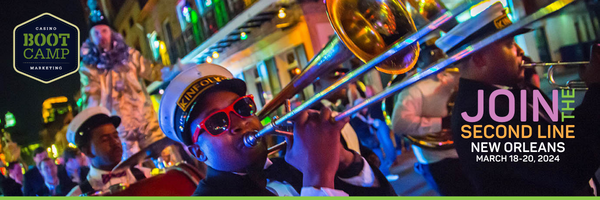Building customer loyalty is a top priority for any casino business. However, relying solely on free play to keep customers coming back can be challenging and expensive. That is why branding your casino is crucial. By creating a strong and recognizable brand, you can foster customer loyalty and generate long-term revenue growth, whether you have an online or land-based gaming operation.
Branding goes beyond just a name and logo. It involves shaping people’s perception of your business through design, messaging, and overall experience. A successful casino brand encompasses all these elements, becoming the foundation of effective marketing.
A robust brand builds customer loyalty, enhances satisfaction, and boosts revenue. Consistency and coherence are essential to creating a successful brand that should be implemented across all touchpoints, from the casino floor to training materials. By prioritizing branding, you can establish a unique identity and gain a competitive edge in the industry.
Post-Pandemic Branding and Loyalty
The pandemic has significantly changed consumer behavior and expectations, making it harder to predict their preferences. Patrons returning to casinos are now prioritizing their health and safety, which is as important as winning a jackpot. They are seeking experiences beyond just gambling and want assurance that their well-being is a top priority.
To meet these new preferences, casinos must adapt their loyalty programs. It’s no longer only about offering free rooms or earning points. Today’s customers want loyalty rewards that address their concerns, such as health-focused perks, wellness options, advanced cleaning protocols, touchless transactions, and tailored rewards on their screens.
Adapting means combining safety with excitement, such as providing VIP experiences that include private gaming areas that are sanitized to perfection or hosting health-conscious events. It’s about achieving the perfect balance between responsible gambling and the excitement of playing. Casinos remain the epitome of entertainment.
Big Data and Hyper-Personalization: Revolutionizing the Game
The byproduct of big data is a level of hyper-personalization that can ensure every guest can feel like a VIP. Casinos have long used big data to understand the value of a guest. Today, however, marketers are expanding their use of the data they have to understand their clientele and anticipate their needs, crafting experiences that are as individual as the patterns on a deck of cards. We can all agree we are taking customer understanding to a new level.
Customer Segmentation with Big Data
A segmentation strategy ensures each guest is placed in a niche that resonates perfectly with their preferences and behaviors. We go beyond simply knowing who enjoys slots or tables; we can understand the social dynamics they relish on the gaming floor. From favorite games to entertainment choices, dining preferences, and optimal visit times, we can be in tune with the complete patron experience.
Hyper-Personalization with Advanced Analytics
Advanced analytics takes the raw data and transforms it into a personalized playbook. Tailored offers, customized game recommendations, and custom event invitations are no longer a shot in the dark but a strategic move in creating a seamless and gratifying casino experience.
AI-Driven Individualization
When AI and machine learning enter the game, the stakes are raised. These technologies can predict the next move of a patron, offering an individualized experience that is as wise as the most seasoned host. AI taps into a patron’s history and current behaviors to suggest new games they might enjoy or upcoming shows that resonate with their tastes. It’s a concierge service powered by silicon but as warm as the most personable host.
By blending the insights gathered from big data with the predictive power of AI and the nuanced touch of personalized service, casinos can offer a hyper-personalized experience that not only meets but exceeds the expectations of their guests. In this high-tech, high-touch environment, loyalty is not just won—it is earned, one personalized experience at a time.
Experiential Marketing Innovations
Experiential marketing in casinos isn’t just about splashing logos on cocktail napkins or having mascots walk the floor. It’s about creating branded events that are as immersive and thrilling as the casino games. Imagine a New Year’s Eve bash where the theme isn’t just glitz and glam but an interactive mystery game, with guests following clues throughout the casino to win exclusive rewards. Or picture a high-stakes poker tournament where the table isn’t in a room but in a luxury penthouse suite, with a view that tells players this isn’t just a game – it’s a once-in-a-lifetime experience.
 The key to these events is to infuse the casino’s brand into every element, from the invites that mimic a game of chance to the decor that reflects the casino’s most iconic games. It’s about ensuring that the event tells a story, one where the guests are the main characters and the casino is the setting for their adventures.
The key to these events is to infuse the casino’s brand into every element, from the invites that mimic a game of chance to the decor that reflects the casino’s most iconic games. It’s about ensuring that the event tells a story, one where the guests are the main characters and the casino is the setting for their adventures.
Promotions That Resonate
When it comes to promotions, the traditional drawing or spin-the-wheel won’t cut it anymore. Innovative promotions now involve a blend of technology and real-world excitement. Consider such advancements as an augmented reality treasure hunt that starts in a digital channel and leads to physical prizes hidden around the casino. Or virtual reality slot tournaments where players can compete in fantastical, immersive 3D worlds, earning real-world rewards.
The goal is to create promotions that are about more than just winning—they’re about experiencing something unique and shareable. In today’s social media-driven world, a promotion that gets guests posting, tweeting, and sharing is worth its weight in gold.
The Role of Personalization
In this era of easy customization, the one-size-fits-all approach to events and promotions is yesterday. Personalization is the name of the game. By leveraging data (there it is again!), casinos can create events and promotions that speak directly to individual preferences. A slot player might receive an invitation to a new game’s launch party with free spins. A foodie might be tempted by a gourmet dining event hosted by your chef, with a menu crafted around a seasonal theme.
Experiential marketing in the casino industry is about creating a buzz, yes, but more importantly, it’s about creating an emotional connection between the brand and the guest. It’s about offering experiences that cannot be replicated anywhere else, that turn a night at the casino into a story to be told and retold. In the end, it is these stories that keep guests coming back for more because the best experiences are the ones that are both lived and relived.
The Importance of Community
For most regional operators, the community is not a third party; it’s part of the house. As local markets’ diversity evolves, so must the branding strategies of casinos to reflect the rich tapestry of cultures, values, and voices within their communities.
Casinos operate in a kaleidoscope of communities, each with its unique blend of demographics and cultures. Recognizing and embracing this diversity means updating marketing images to showcase a more comprehensive array of faces, hosting events celebrating local traditions, and offering games resonating with regional preferences. It’s about speaking the language, both literally and figuratively, of the community that turns the wheels of the local economy.
Achieving diverse representation in casino branding requires more than just checking boxes. It requires an authentic and ongoing dialogue with the community to understand what makes it tick. This could mean collaborating with local artists for unique interior designs that tell the community’s story or hosting cultural festivals that bring the casino’s brand to life in vibrant, colorful ways. By mirroring the community’s diversity in every facet of the casino—from the employees to the entertainment lineup—brands can create a welcoming environment that feels like home.
Community outreach is the ultimate winning move in branding strategies. It builds bridges between the casino and the public, fostering goodwill and trust. Whether it’s sponsoring local sports teams and programs or supporting charity events, these initiatives show that the casino isn’t just a place to gamble. It is a pillar of support for the community. When people see a casino brand giving back, it is not just an image boost but a heart connection that can translate to brand loyalty.
Corporate Responsibility and Brand Image
Today, corporate responsibility goes beyond mere philanthropy; it is a fundamental element of a casino’s brand image. It’s about responsible gaming programs that advocate for mental health, sustainability efforts that align with the community’s environmental goals, and employment practices that promote fairness and opportunity. A casino that not only operates responsibly but also communicates its efforts effectively will see its brand elevated not just in the eyes of the patrons but also in the community’s collective conscience.
The community is the lifeblood of the casino industry, and a brand that resonates with the heart of its community will thrive. Casinos can transform their brand into a beacon of trust and loyalty by embracing the diversity of the local markets, engaging in meaningful representation, actively participating in community outreach, and upholding corporate responsibility. Ultimately, a casino that stands tall as a responsible member of its community will be embraced as a treasured entertainment destination woven into the fabric of local life.
Revolutionizing Casino Loyalty Programs
In today’s digital age, the traditional loyalty card is getting a face-lift, morphing into a dynamic tool powered by the latest technology. Casinos are now playing the long game, recognizing that the key to a patron’s heart is through experiences tailored to their tastes, made possible by tech-infused loyalty programs.
The integration of technology into loyalty programs is giving casinos an edge in the game of customer retention. Mobile apps now serve as digital wallets, loyalty card holders, and personalized event organizers, providing guests with a virtual casino experience in their pocket. Through these apps, patrons can check their loyalty points balance, book hotel rooms, reserve seats at shows, and even receive targeted recommendations for games they might enjoy based on their play history.
There are innovative takes on loyalty programs.
Tiered Loyalty Programs with Experiential Rewards: Moving beyond the one-size-fits-all model, casinos are adopting tiered loyalty programs that offer escalating rewards. It’s not just about earning points for play anymore. Now, loyalty could mean an invitation to an exclusive tasting event with a celebrity chef for food lovers or a private gaming session with a renowned player for the card enthusiast.
Personalized Promotions Using AI: By utilizing artificial intelligence, casinos can analyze individual gaming patterns and preferences to offer personalized promotions. A patron who enjoys the slots could receive notifications for free spins on their favorite machines, while a table games player might get an exclusive offer for a VIP event or tournament.
Gamification of Loyalty Rewards: Taking a page from the video game industry, some casinos are gamifying their loyalty programs, turning point accumulation into an interactive game. Patrons can complete challenges or missions – like trying a new game or attending a show – to unlock rewards. This not only incentivizes a broader exploration of the casino’s offerings but also adds an element of fun that transcends traditional gambling.
Integrated Resort Experience: Some casinos are tying loyalty points to the entire resort experience, allowing guests to earn and redeem points not just on the casino floor but at spas, golf courses, and retail outlets. This holistic approach treats the entire stay as part of the loyalty experience, encouraging patrons to immerse themselves in all the property’s amenities.
By leveraging technology to understand and cater to individual preferences, casinos transform loyalty programs from a simple transactional relationship into a personalized journey. With each innovation, they’re dealing a better hand to their guests, ensuring that the odds are ever in favor of a long and rewarding relationship.
The Power of Brand Resilience in Times of Crisis: Building Trust and Maintaining Stability
When faced with adversity, a solid brand serves as a stronghold, offering stability and preserving customer and employee trust. The accurate measure of a brand’s strength emerges during crises when external pressures put its business operations and customer perceptions to the test.
A robust brand is built not only on the quality of its products and services but also on the consistency of its values and the reliability of its customer experience. In times of crisis, these elements become critical. A brand consistently communicating its core values and building a rapport with its customers and employees can rely on this foundation to maintain stability. Stakeholders are likelier to remain loyal to a brand they trust, even when the going gets tough, because they associate the brand with dependability and strength.
Effective communication is paramount when navigating through challenging times. Brands must be transparent and proactive in their messaging, providing clear, consistent information that addresses concerns and demonstrates empathy. This involves not only sharing facts but also articulating what the brand is doing to manage the situation and support its customer base.
Timely and responsive communication can help to mitigate uncertainty and build confidence. This means reaching out through traditional channels and engaging with stakeholders where they are most active, whether through social media, email, or direct engagement.
Crisis management and brand resilience are about the preemptive establishment of trust and strategic communication navigation during crises. Brands with solid identities and transparent communication strategies are better equipped to weather storms and emerge with customer loyalty intact. This resilience can turn a challenging situation into an opportunity to reinforce brand strengths and customer relationships.
Unlocking the Power of Employees as Brand Ambassadors
In any business, every employee is a part of the house hand, and when played right, they are the trump cards of brand representation. Every employee holds the key to success as the face of the brand. By harnessing their potential, they can elevate the brand to new heights. Equipping and empowering staff with comprehensive training programs is crucial. It’s more than just mastering the game; it’s about embodying the brand’s essence.
Training should go beyond uniform standards and clocking in. It should immerse employees in the brand’s story, customer care standards, and core values. Empowering them to make autonomous decisions that align with the brand’s commitment to guest satisfaction is critical.
Empowering staff means allowing them to make on-the-spot decisions that align with the brand’s commitment to guest satisfaction. It’s the power to comp a meal for a couple celebrating an anniversary or to offer a room upgrade to a loyal patron without a cascade of managerial approvals. When staff are trusted to act as the face of the brand, they deal each guest a winning experience.
Employee Engagement and Customer Satisfaction
Employee engagement is the jackpot of customer satisfaction. Engaged employees don’t just work at the casino; they are part of its essence. They greet guests by name, remember their favorite drinks, and share in the excitement of their wins. This kind of engagement is infectious, turning a night out into a memorable event.
Casinos that score high on employee engagement often find that their guests rate their experience higher, too. Engaged employees are more likely to go the extra mile, ensuring that guests aren’t just satisfied but delighted with their experience.
When employees are fully trained and empowered to deliver on brand promises and engaged and invested in the casino’s success, they become the ultimate brand ambassadors. They are the ones who will carry the brand’s story forward and create experiences that guests will not only remember but will keep them coming back for more. In the bustling environment of a casino, where every guest interaction is a chance to win loyalty, a well-trained and engaged staff is the best bet for delivering consistently high-quality experiences.
Measuring & Adapting Brand Strategies for Customer Loyalty
As any seasoned marketer knows, customer brand loyalty can make or break a business. Measuring and adapting to improve this loyalty should be at the forefront of any marketing strategy. Knowing how effective your brand marketing strategies are can help you optimize your brand and improve its value. But, like all things, not all metrics are created equal, and measuring the right ones is crucial for developing and evolving your brand strategy. Here are a few key metrics for evaluating customer loyalty and brand perception:
- Net Promoter Score (NPS) measures how likely customers are to recommend your brand to others.
- The Meczka Gaming Index enhances traditional gaming patron satisfaction measures, indicating where casinos may need to improve to make their products and offerings the first choice among patrons.
- Customer Lifetime Value (CLV) can identify your most valuable customers and segment your marketing strategies accordingly.
In addition to the traditional survey, brand awareness can be tracked through social media mentions, website traffic, or brand search volume.
Once you have established your key performance indicators, monitoring and adapting your branding strategies is essential. Conducting customer satisfaction surveys and feedback to identify areas of improvement is one of the best ways to get customer insights. Gathering customer feedback can provide valuable insights into their preferences, pain points, and opinions about your brand. Also, watch for the latest market trends and adapt to new technologies or promotional activities that can help improve customer interactions and experience with your brand.
Measurement, however, is only one step in building lasting brand loyalty. Investing in your customer’s experience is also vital to building brand loyalty. Addressing your customer’s concerns promptly and empathetically is necessary to achieve this. One of the best ways to do this is by providing a seamless customer interface across multiple brand channels, allowing customers to engage with your brand effortlessly. Another effective strategy is personalizing customer service, reflecting on their past preferences and spending, and acknowledging their feedback. This small step in personalization has been shown to improve loyalty rates as customers feel valued and understood.
Building and maintaining loyalty is a never-ending process, and it’s something that takes time to achieve. Measuring the effectiveness of your branding strategies is just the beginning of creating a brand that resonates with your customers. It requires continuous monitoring and adapting to meet your customer’s ever-changing expectations. You can achieve customer and brand loyalty by continuously gathering customer feedback, staying updated with market trends, and adjusting accordingly.




Recent Comments